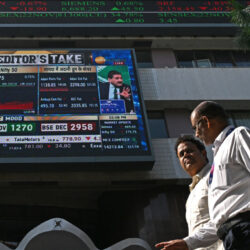
Current geopolitical discourses often use concepts such as multipolar world, inflection point, de-globalization, and de-dollarization. All these terms are code for claims that the United States’ hegemony and the U.S.-backed liberal order are in decline. Though the subject is one of debate, many experts in the field argue that we now live in a multipolar world. New powers such as the BRICS bloc (led by Brazil, Russia, India, China and South Africa) are rising, and the unipolarity the U.S. enjoyed since the end of the Cold War is dissipating. De-dollarization has become more urgent among non-Western nations because of the way in which the U.S. has weaponized the dollar and used economic sanctions to punish and pressure nations to submit to its foreign policy.
What is Dollar Dominance?
One key cause, as well as consequence, of U.S. hegemony is dollar dominance. It is safe to say that the status of the U.S. dollar as the dominant global reserve currency is one of the key sources of U.S. hard power. Hence, asking if de-dollarization is happening is the same as asking if US hegemony is declining.
Dollar dominance is easy to measure. The dollar today constitutes 59% of the global reserves, followed by the euro, the Japanese yen, British pound, and the Chinese yuan. Even today, 88% of all foreign exchange transactions and 54% of export invoicing happens in dollars, necessitating the involvement of U.S. banks. This reality enables the United States to borrow money at a much cheaper rate and gives it enormous unilateral capacity to impose economic sanctions on other nations.
But in recent years we have witnessed the decline of the U.S. dollar as a reserve currency from a high of 71% in 2000 to 59% in 2023. The dollar’s reduced share of international invoicing stands at 54%, primarily because of the euro. In the Americas, the dollar is 96% of foreign invoicing, and in the rest of the world , including Asia, its share is over 70%. Clearly there is a lot of talk of de-dollarization, and there is evidence to suggest that it is indeed happening slowly and marginally, but the dollar remains robustly dominant.
De-Dollarization Trends
Two coalitions of nations – one incidentally and one geostrategically – are bringing about de-dollarization. European nations, by virtue of the euro as the currency of the European Union, have effectively excluded the dollar from 15% of the global economy and 100% of the intra-EU trade. This is not designed to weaken the United States but rather to strengthen the European Union.
The BRICS collective is acting with a geostrategic purpose to reduce the power of the dollar. This in turn will precipitate a decline in U.S. hegemony and give these nations greater autonomy on the international stage because it will be harder for the United States to sanction them. De-dollarization for BRICS is a path to a truly multipolar global order.
So far, there is no effective BRICS currency. The Chinese yuan has barely a 3% share of the foreign exchange reserves, and the BRICS countries themselves are among the leading hoarders of dollars. While the status of the dollar as a reserve currency is not diminishing rapidly, the non-dollar trade is on the rise. At present, 46% of all export invoicing is done in non-dollar currencies. The rise in non-dollar trading also means that the U.S. capacity to regulate who trades with whom and to levy sanctions is declining.
Trump’s Threat
President elect Trump announced that he would levy 100% tariffs against BRICS nations if they move ahead with their plans for de-dollarization to create a BRICS currency and undermine the power of the “mighty dollar.” This threat might not deter China and Russia, but both Brazil and India are vulnerable and might backtrack on de-dollarization. If Trump actually acts on this threat, India could leave the BRICS.
Net Assessment
De-dollarization is happening, but not at an alarming rate. The only currency challenging the dollar is the friendly euro. The BRICS are talking about de-dollarization, but their internal divisions undermine their geostrategic goals of de-dollarization and creating a BRICS currency. The only meaningful shift is the growing non-dollar international trade. The global economy needs a stable and widely accepted global currency. If the United States exercises self-restraint, then the dollar will rule. But if Washington keeps using unilateral sanctions it will hasten de-dollarization, the rise of the Chinese yuan, and the fragmentation of the global economy. President Trump’s threats may slow down de-dollarization efforts by India and other nations that rely on US for security and trade, but nations like China, Iran, and Russia which are under sanctions and feel US pressure may start working harder to reduce the power of the dollar.
This photo taken on May 5, 2023, shows a street decoration of the logo of the 2023 ASEAN Summit in Jakarta, where the alliance discussed economic growth and de-dollarization. (Photo by Xu Qin/Xinhua via Getty Images)





